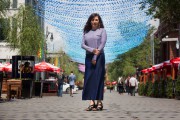MEDIA
A Montreal brand is trying to stand out in the sale of anti-UV clothing
UV-protective clothing can be a useful addition to sunscreen.
HuffPost Quebec
1-Protective clothing against UV rays: everything but a scam
Published on
Fashion columnist Madeleine Goubau was skeptical about clothing with an ultraviolet protection factor (UVF) rating. But behind these three letters lies more than a marketing argument, as she explains on Sophie-Andrée Blondin's microphone.
The criteria behind the FPU acronym
The UPF index followed by a number attests to the fact that the garment has been tested in the laboratory, on dry and wet fabric, stretched and relaxed. The higher the index, the more the clothing protects. If the index is 50, this means that the fibers that make up the clothing allow one-fifty of ultraviolet (UV) rays to pass through, and therefore block 98% of rays. “The FPU mention reassures us,” explains Madeleine Goubau.
To best protect against ultraviolet rays, this clothing must combine several characteristics. First of all, high UPF fabrics should be made of synthetic fibers rather than natural fibers. Polyester, for example, has more coverage than cotton. The weave of the garment also matters: the tighter it is woven or knitted, the higher the protection will be. And finally, its color should not be neglected: the darker or brighter ones should be preferred by consumers, because the pale shades allow more rays to pass through.
Clothing wins over sunscreen
Over the past 25 years, cases of melanoma have more than doubled in the country, and these are mainly due to ultraviolet rays. For the Canadian Cancer Society, between clothing offering UPF protection of 50 and sunscreen with a sun protection factor (SPF) of 50, clothing is preferred because it provides more complete protection.
A limited offer for now
For the moment, FPU clothing is not numerous, and these are most often found in the sports range. But a young Montreal company, Izol UV, recently launched into city clothing with a high UPF index. Madeleine Goubau observed their production: “They are very covering, light, stretchy clothes, but they are not cheap, because they are made in Quebec,” she explains.
In addition
- IZOL UV - Montreal brand of clothing with a high protection factor against ultraviolet rays
- Children protected from the sun - Canadian Cancer Society
- The memory of the skin: what you need to know about sun protection from childhood.

The Press
Not all textiles are effective in protecting the skin from UV rays.
Published on July 28, 2017 at 08:00 | Updated July 28, 2017 at 8:00 a.m.
Sun protection: the new anti-UV weapon
Because sunscreen is not enough to adequately protect yourself from the sun, clothing with anti-UV properties is becoming more and more numerous on the market. Why and how to choose them? La Presse takes a look at the issue and suggests clothes to help you spend the summer outside in complete peace of mind.
In the sun, without worry
Sunscreen is good. But in a world where we are increasingly aware of the dangers associated with exposure to the sun's rays and where cases of skin cancer are on the rise, clothing offering protection against ultraviolet rays is becoming increasingly necessary. as a complementary and safe solution in addition to sunscreen lotions. Overview of the subject in four questions and answers.
Why does ordinary clothing fail to effectively protect us from the sun?
Clothing does provide protection against UVA and UVB rays, but some may not protect you as much as you think. A light white cotton t-shirt, for example, offers protection against UV rays (known as UPF) of between 4 and 7, which is very little. So yes, the skin can burn even if you are wearing clothes. The founder of the anti-UV clothing line Cabana Life, Melissa Papock, learned this the hard way, having been diagnosed with skin cancer at age 26: “At the time, in 2001, my dermatologist had to explain to me what anti-UV clothing was. Even though I worked in fashion, I had never heard of it!” But things are slowly changing. Moreover, since last year, the Canadian Cancer Society has revised its recommendations regarding sun protection and now advises covering up as much as possible with clothing that is tightly woven or identified as protecting against UV rays.
How to ensure that clothing protects against ultraviolet rays?
Two ways: by selecting a textile that adequately protects or by purchasing clothing identified as anti-UV. As the World Health Organization indicates, knitted or tightly woven fabrics, dark colors and heavy fabrics will block UV rays more, while wet or worn clothing will lose its protective properties. Thus, according to the Skin Cancer Foundation, jeans have a UPF of 1700, meaning that they allow barely 1/1700 of UV rays to pass through. The problem is that we don't particularly want to wear a black sweater or heavy jeans in the middle of a heatwave! This is why more and more companies are designing anti-UV clothing made with lightweight, breathable and quick-drying materials for greater comfort.
What does UPF mean and how is this factor calculated?
Developed by the American Association of Textile Chemists and Colorists in 1998, the Ultraviolet Protection Factor, or UPF (in French: FPRUV, or protection factor against UV rays), is today widely used in several countries, although there is still no international standard. The number associated with a garment's UPF indicates the proportion of UV rays that are filtered by it. So a UPF of 50 indicates that 1/50 of the rays pass through the material, or 2%. The UPF normally varies between 15 and 50, clothing with a UPF below 15 cannot be considered anti-UV. Various laboratory tests are used to determine the UPF of a garment. Please note: some companies use the acronyms SPF and UPF interchangeably, although SPF normally indicates the amount of time you can spend in the sun before your skin turns red.
How do Ultraviolet Protection Factor (UPF) materials effectively protect against the sun?
Some companies simply select materials that offer a high UV protection factor thanks to their weave and properties. These are often blends of nylon, elastane or polyester, with synthetic materials generally being more effective at protecting from the sun. Others will specially treat their textiles with chemical UV absorbers, in order to increase the protection factor of the clothing. The latter, however, have the disadvantage of becoming less effective over time. Companies are also designing their own technologies by integrating UV absorbers into their textiles. For example, at Columbia, all pieces in the Omni-Shade collection - recommended by the Skin Cancer Foundation - offer a tightly woven design, with fabrics to which UV absorbers and ceramic reflectors are added, to better reflect the sunlight.

IZOL UV founder Mahtab Azizsoltani (pictured in her designs) wants to offer a more stylish option for those looking to protect themselves from the sun.
PHOTO OLIVIER PONTBRIAND, THE PRESS
Protect yourself in style Newly arrived on the anti-UV clothing market, the Quebec company IZOL UV stands out by offering urban clothing that can be worn every day. Its founder, Mahtab Azizsoltani, has made it her mission to make people aware of the harmfulness of UV rays, while helping them to better protect themselves... with style.
It was following a serious sunburn on his arms that Mahtab Azizsoltani developed an intolerance to the sun. No longer able to stand the sun - or sunscreen - so she started covering up by wearing cardigans.
Wanting to find an alternative to clothes that were too hot for the summer season, she quickly noticed that in the anti-UV clothing section, a sporty look was in order.
“The sporty look is in and people are doing a lot of outdoor activities, which is good. But for everyday life, I couldn’t find anything on the market that suited me.”
From there the idea of IZOL UV was born. Launched last year, the Quebec company - all of whose items are designed and made here - wants to offer a more elegant option to those looking to protect themselves from the sun.
From the beach to the city
First we had to find the right material. And it was by observing Asian women at the beach, covered from head to toe by their swimsuits, that the HEC Montreal management graduate had the idea of looking for a textile similar to those used for swimsuits. bath.
The one she chose, a blend of elastane and polyamide (sometimes recycled), is imported from Italy. It also plans to soon introduce a fabric of the same type, but made in Canada, so that its product is as local as possible. “These are very tightly woven fabrics, but they are breathable and light and very silky,” she says.
“They really protect from the sun, even the white ones, which allow you to stay cool even when you are directly exposed.”
Self-taught (she is also a painter in her spare time), she creates and draws her own models with simple lines and clean silhouettes, which offer maximum coverage while remaining urban. Then, she works with a pattern maker to bring her models to life. Close-necked sweaters, long skirts, dresses, scarves, capes and wide-legged pants make up the staples of IZOL UV's wardrobe.
A growing interest
Very aware of the harmful effects of the sun - it can cause skin cancer, but is also a factor in accelerating skin aging, she notes -, Ms Azizsoltani hopes that, in the near future, anti- UV will become a staple in people's wardrobe and even - why not? - a necessity item covered by insurance!
“For the past year, things have been moving and changing. People are more and more aware of these tissues and are more sensitive to the subject,” she notes, adding that her clientele consists of as many people who have suffered or are suffering from skin cancer as others who seek to protect yourself adequately.
IZOL UV products are available online as well as at the Neoshop Montreal pop-up store.
Better protect workers who work outdoors Launched last year by the Canadian Dermatology Association, the Sun Safety at Work pilot project offers employers the opportunity to follow a program to create a safe environment for their workers who spend a part of their day outside, for example by giving them access to anti-UV clothing. Those who work outdoors are 3.5 times more likely to develop skin cancer than those who work indoors. A subject that is of recent interest to the mayor of the Le Sud-Ouest district, Benoit Dorais. “Looking into the occupational health and safety of our employees, particularly those who work in the sun, is one of our annual objectives.” It was after discovering Ms. Azizsoltani's products that he decided to use her services. The command ? Nearly 180 IZOL UV anti-UV sweaters that the district's 90 lifeguards will wear next week by the swimming pools. “Most of our lifeguards are young, so it’s a good time to do prevention.” This pilot project could grow and extend to other blue-collar workers who work under the sun, such as gardeners.
Save Save Save Save Save Save Save Save Save Save Save Save Save

